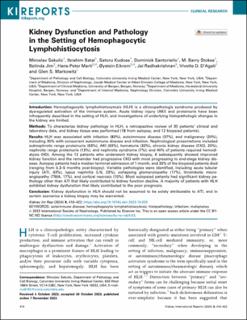| dc.description.abstract | Introduction
Hemophagocytic lymphohistiocytosis (HLH) is a clinicopathologic syndrome produced by dysregulated activation of the immune system. Acute kidney injury (AKI) and proteinuria have been infrequently described in the setting of HLH, and investigations of underlying histopathologic changes in the kidney are limited.
Methods
To characterize kidney pathology in HLH, a retrospective review of 30 patients’ clinical and laboratory data, and kidney tissue was performed (18 from autopsy, and 12 biopsied patients).
Results
HLH was associated with infection (83%), autoimmune disease (37%), and malignancy (20%), including 30% with concurrent autoimmune disease and infection. Nephrological presentations included subnephrotic range proteinuria (63%), AKI (63%), hematuria (33%), chronic kidney disease (CKD, 20%), nephrotic range proteinuria (13%), and nephrotic syndrome (7%); and 40% of patients required hemodialysis (HD). Among the 12 patients who underwent kidney biopsy, 6 subsequently showed improved kidney function and the remainder had progressive CKD with most progressing to end-stage kidney disease. Autopsy patients had a median terminal admission of 1 month, and 33% of the biopsied patients died (ranging from 0.3–5 months post-biopsy). Variable pathologies were identified, including acute tubular injury (ATI, 43%), lupus nephritis (LN, 23%), collapsing glomerulopathy (17%), thrombotic microangiopathy (TMA, 17%), and cortical necrosis (10%). Most autopsied patients had significant kidney pathology other than ATI that likely contributed to kidney function decline. A majority of patients with HLH exhibited kidney dysfunction that likely contributed to the poor prognosis.
Conclusion
Kidney dysfunction in HLH should not be assumed to be solely attributable to ATI, and in certain scenarios a kidney biopsy may be warranted. | en_US |

